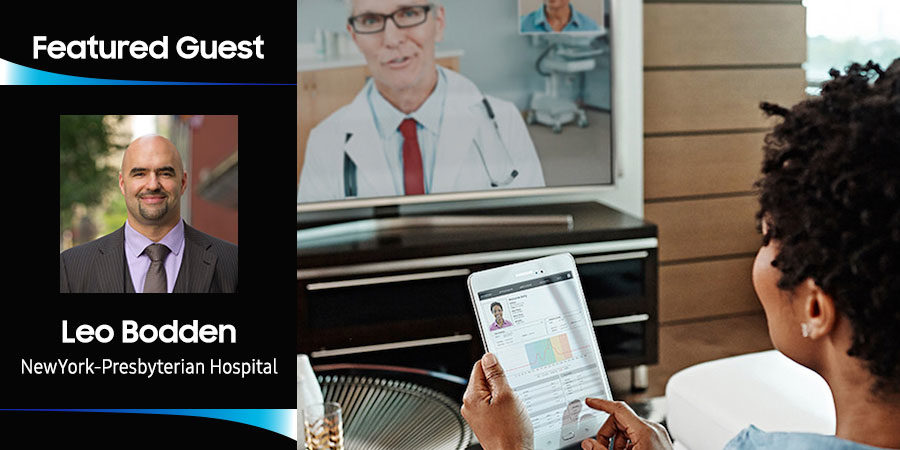Editor’s Note: This conversation is part of our ongoing “Future State Of” series. It has been edited for length and clarity.
U.S. healthcare has undergone significant recent changes. But perhaps nothing will impact our healthcare system more than the COVID-19 crisis.
To reduce the spread of the disease and maintain capacity, hospitals and healthcare facilities deferred in-person appointments and nonessential procedures until the virus was better contained. As a result, the application of telehealth has dramatically increased. In fact, virtual healthcare visits surged 50 percent in March and are on pace to top one billion by the end of 2020.
While telehealth is not new, there have previously been barriers to its widespread adoption, like cost, technology and patient acceptance. But now that doctors and patients alike have experienced telehealth at scale, will it become standard practice in the next normal?
Taher Behbehani, GM and SVP of Samsung B2B, sits down with Leo Bodden, CTO of NewYork-Presbyterian Hospital (NYP), to discuss topics including the impact of the crisis on healthcare in general and the role telehealth will play in the future — both in and out of the hospital. Based in the initial U.S. epicenter of the pandemic, Leo and the NYP team have navigated incredible challenges during this crisis and adapted quickly, moving 3,000 staff members to full-time remote work and conducting many patient visits virtually. For context, the number of virtual visits at NYP increased from 4,000 to 24,000 per week in April!
Taher Behbehani: Hi Leo, and thanks so much for your time. At this stage in managing the pandemic, what would you have done differently? And what should the industry overall have done differently?
Leo Bodden: Hi Taher, happy to be here. The first thing we would have done differently, and I think this is consistent among my colleagues, is not question the data. Globally, where most countries fell on their faces, had to do with the assumption it would be different for them. Instead, they (and we) should have closely tracked the trendlines — such as what was happening in Italy and what was happening in China — and responded far quicker.
I say this to colleagues all the time: We (the U.S.) were fortunate that the virus hit New York first, because compared to some other states in the nation, this is a fairly rich state. Then we (in New York) were fortunate it hit NYP, since NYP is very well managed and well funded. As an organization, we were able to make all the investments that needed to be made to support the patients and our communities.
I am very proud of the way NYP ultimately responded, but if there was one thing that we would do differently it’s questioning the data. The moment we did that, we as an entire organization moved in the same direction, and we were able to build the capacity that we needed very, very quickly.
TB: Was there an “aha!” moment for you and your organization as the pandemic expanded?
LB: The “aha” moment was when we began seeing patients who seemed perfectly fine, and then suddenly decompensated to the point where we needed a rapid response team to get them back.
Those were things that we were hearing from Italy from the very beginning. It was one of our COOs who said, “what we saw with this patient is very close to what I have been hearing from colleagues in Italy.” And when we made that connection, we realized that we were about to see the same thing that Italy saw.
TB: That’s interesting, when personal or professional first-hand experience matches the data, then something goes off in the human mind, saying “Wow, it’s true! This is really happening!” Right?
LB: Exactly.
TB: Before the pandemic, NYP was already engaging in telehealth services. But the pandemic has really raised the potential and profile of telehealth services. Do you think this trend has staying power?
LB: It is an expectation now. We had a robust telemedicine program before the pandemic. I would argue that it was number one or number two in the country for a healthcare organization. And then the pandemic hit, everyone invested millions, caught up and now we are basically average. What is interesting now is that if you do not have it as an option, you are not going be a provider of choice in the future. Forcing people to come into the four walls of a hospital no longer makes sense, especially when services can be rendered virtually.
So yes, it is here to stay. We must have it as an option if we are going to remain relevant in the next couple of years.
A big problem with the current model is that the returns are not on par with physical visits. There need to be adjustments in how we fund it, how we charge for it and ultimately how it aligns with the other services we are providing.
TB: What kind of impact is telemedicine having on your business model?
LB: Financial. If, for example, a hospital charges $100 for an in-person hospital visit, a comparable virtual (telemedicine) visit earns $33. In other words, one roughly generates a third of the revenue for telemedicine visits versus physical. Over time, like other digitized services, we will see more downward pressure. The per-visit returns for basic telemedicine will continue declining, requiring volume to make up for the difference, assuming returns are to be maintained year-over-year.
TB: This is a big shift for the entire industry and will probably drive new technology. What are some of the technology barriers your industry is facing to make this new paradigm work?
LB: Regulatory. As an example, before realistically using (consumer) wearables in a healthcare environment, these must go through the rigorous regulatory testing, just like medical devices. However, in a not so distant future, I expect more patients will be using wearables over very expensive medical devices for simple vitals.
While the road forward is extremely complex, imagine a day when a $300 watch can do as well as considerably more expensive medical technology. Hospitals will begin monitoring and supporting patients — even cardiac patients — from home without major investments on infrastructure.
Healthcare organizations are already shifting focus from disease-oriented care (Illness or Sick Care) toward one of wellness and prevention (Wellness Care), and ubiquitous access to inexpensive consumer technology will be its enabler. It will change how organizations provide healthcare services and be a true benefit to patients.
TB: Do you have any concerns about being able to deliver quality care as this digital trend expands?
LB: One of my biggest concerns as we are transitioning to this new virtual/telemedicine world is accessibility for the masses. People in some of the communities we serve cannot afford a $1,000 device. So, if a $1,000 device is required for some of these basic medical services we are discussing, we will have huge disparities between the haves and the have-nots. As you can imagine, there is a huge opportunity here.
We do not have the answer yet, but certainly being able to have this kind of conversation can help us come up with a solution. We need to make sure people who do not have the means can ultimately have access to services that should be rights, not privileges. It is something I truly believe Samsung can certainly help with.
TB: Thanks Leo for sharing all these great insights.
LB: Thank you.
Explore the ways Samsung is leading the charge in the next normal of digital healthcare. And keep up to date with the latest announcements and insights by following Taher Behbehani on Twitter.








